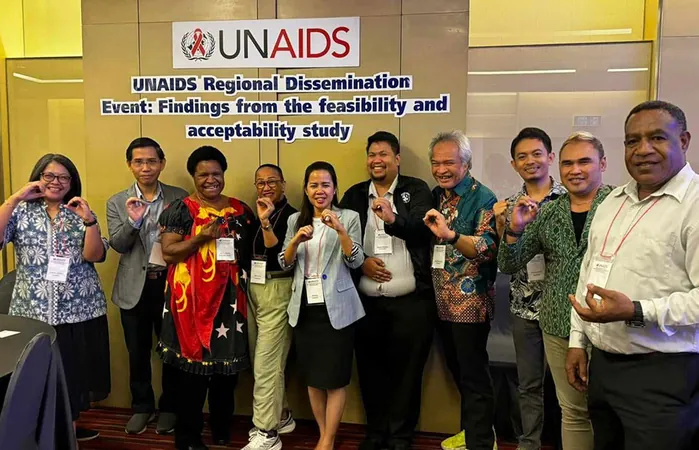
Revolutionary HIV Prevention: The Dapivirine Ring Set to Launch in Southeast Asia!
2024-11-22
Author: Ming
Revolutionary HIV Prevention: The Dapivirine Ring Set to Launch in Southeast Asia!
In an exciting breakthrough for women's health, Cambodia, Indonesia, Papua New Guinea, and the Philippines are gearing up to introduce the Dapivirine Vaginal Ring (DVR), a game-changing tool aimed at reducing the risk of HIV infection among women. For many, like 30-year HIV survivor Elena Felix, the traditional methods of protection like condoms proved inadequate—leading to unwanted exposure to the virus.
Elena, who has become an advocate for HIV research and prevention, shared that many women find themselves in situations where their partners refuse to use condoms or, even worse, where consent is not in question due to sexual violence. “Women need protection that does not depend on men,” she firmly stated, highlighting the pressing need for female-controlled prevention options.
The DVR received endorsement from the World Health Organization (WHO) in 2021, specifically targeting women at high risk of HIV. This innovative silicone ring, worn internally for 28 days, delivers an antiretroviral drug directly to the vaginal tissue, reducing the risk of HIV infection through vaginal intercourse by an impressive 50%. This marks a significant advancement in HIV prevention, especially considering that women, particularly in Eastern and Southern Africa, account for a substantial percentage of new infections.
However, the HIV crisis looks notably different in the Asia Pacific region. Eamonn Murphy, UNAIDS Regional Director for Asia Pacific, warned of a worrying trend—new infections have risen sharply in some areas, while the overall decline in new infections across the region has stagnated at a mere 13%. This alarming statistic was discussed during a recent conference in Bangkok, where various stakeholders, including government officials, researchers, and community members, convened to share insights and outline next steps for the DVR’s introduction.
Research indicates that seven percent of new infections in the Asia Pacific area occur among sex workers, with an additional twelve percent found among their intimate partners. Angeli Achrekar, UNAIDS Deputy Executive Director, passionately argued for expanding HIV prevention options for women. “Choice is the way to go! We must ensure that women have access to innovative tools like the DVR, which can empower them significantly,” she stated.
Despite a new HIV infection occurring every two minutes in the Asia Pacific region, the uptake of pre-exposure prophylaxis (PrEP) has been sluggish, with only 204,000 users reported at the end of 2023—an astonishing 98% short of the target for 2025. Notably, the majority of PrEP users remain men, highlighting a significant gap in women’s access to these vital prevention methods.
Director Elliot Duffy of ThinkPlace revealed promising findings from studies conducted in the region. Women showed a strong interest in the DVR, particularly sex workers, who face heightened risks of sexual violence. They expressed a desire to obtain the DVR through community health services, underscoring the importance of accessibility.
Yet, barriers remain. Many women have questions regarding the use of the DVR, including safety and comfort concerns. “The number one challenge is ensuring women understand how the ring works and addressing their fears,” Duffy explained.
The results from these studies are already paving the way for DVR implementation in 2024-2026, with pilot testing in Cambodia underway. Stakeholders emphasized the need for continued community involvement in the rollout process to ensure that services align with women's needs and preferences.
As momentum builds for the Dapivirine Ring, the conversation surrounding HIV prevention is shifting towards empowering women and celebrating choices that enhance their health autonomy. The launch of the DVR is not just a medical advancement; it represents hope and greater control for women across the Asia Pacific in the fight against HIV.
Stay tuned as we follow this historic journey towards improved HIV prevention for women, which could reshape health outcomes across the region!

 Brasil (PT)
Brasil (PT)
 Canada (EN)
Canada (EN)
 Chile (ES)
Chile (ES)
 España (ES)
España (ES)
 France (FR)
France (FR)
 Hong Kong (EN)
Hong Kong (EN)
 Italia (IT)
Italia (IT)
 日本 (JA)
日本 (JA)
 Magyarország (HU)
Magyarország (HU)
 Norge (NO)
Norge (NO)
 Polska (PL)
Polska (PL)
 Schweiz (DE)
Schweiz (DE)
 Singapore (EN)
Singapore (EN)
 Sverige (SV)
Sverige (SV)
 Suomi (FI)
Suomi (FI)
 Türkiye (TR)
Türkiye (TR)